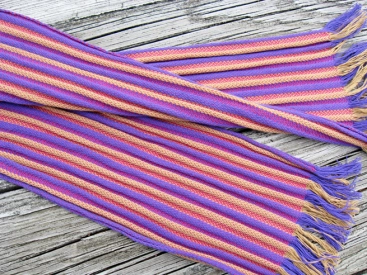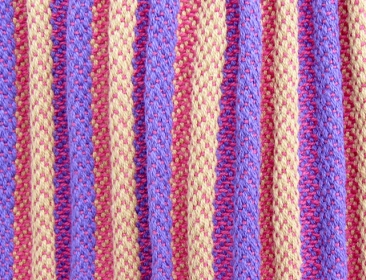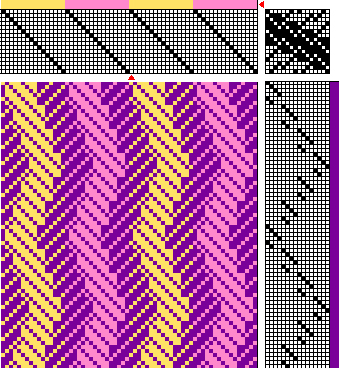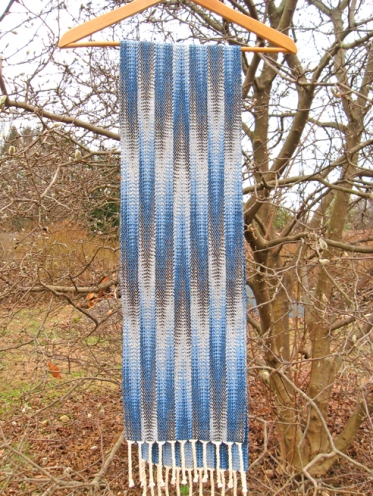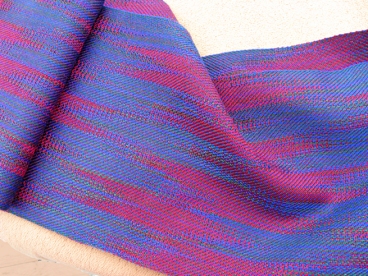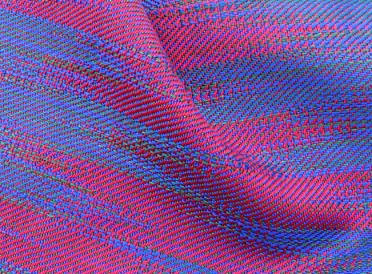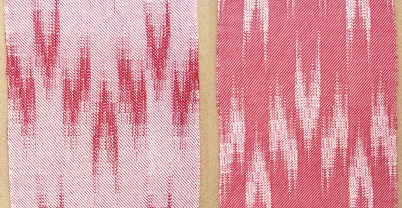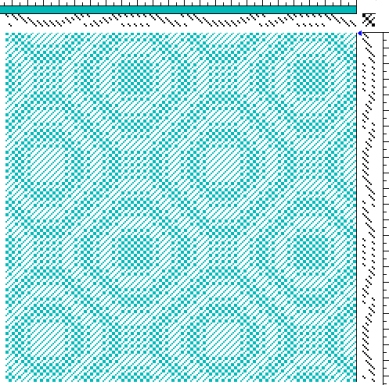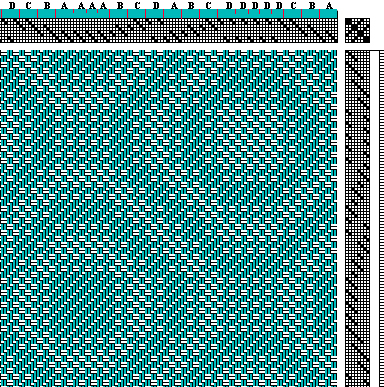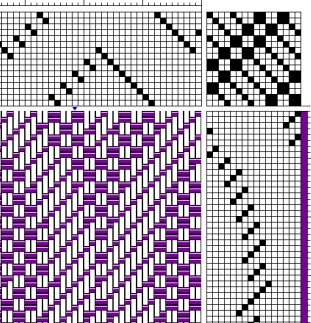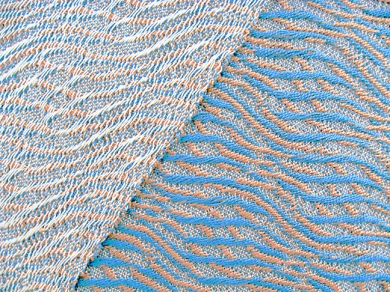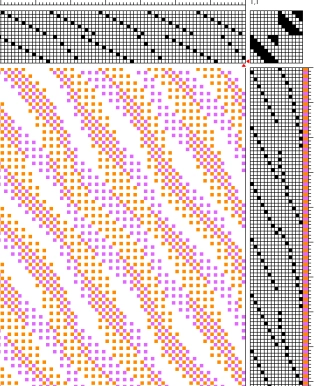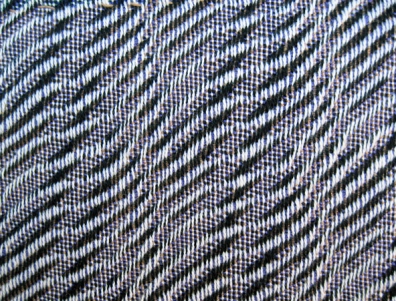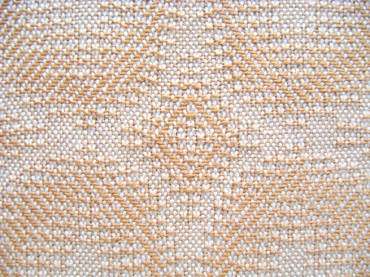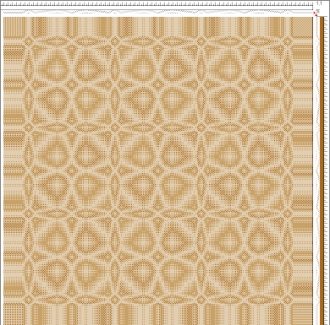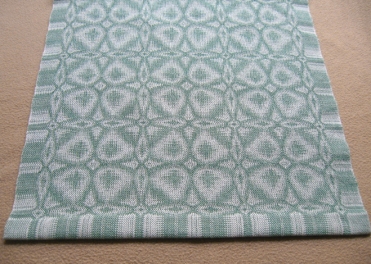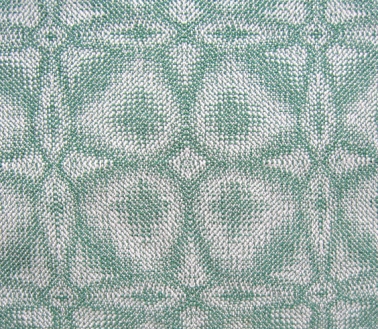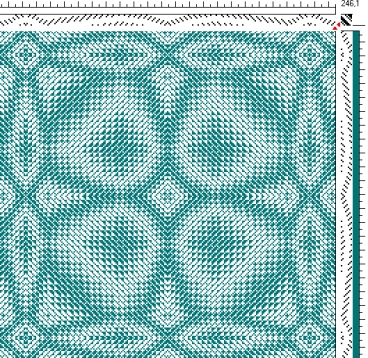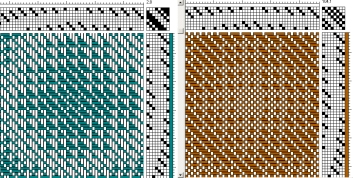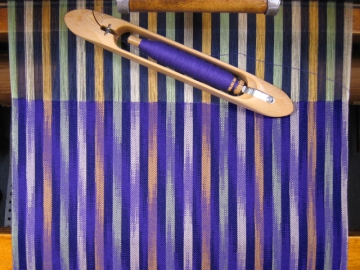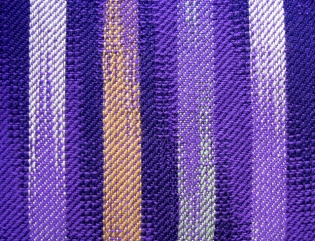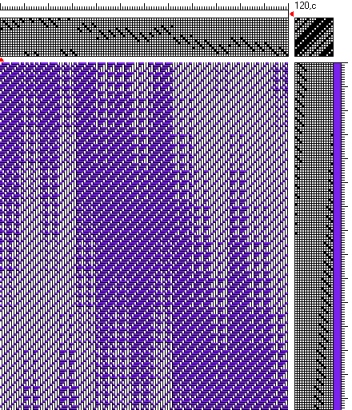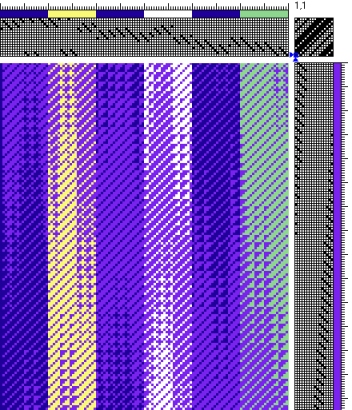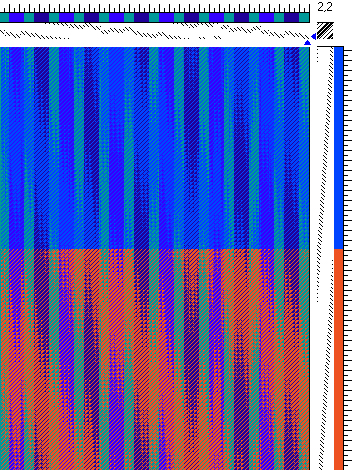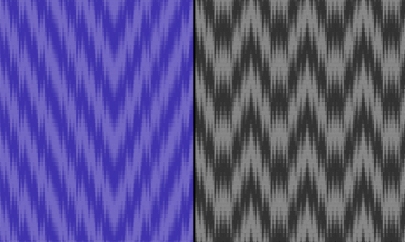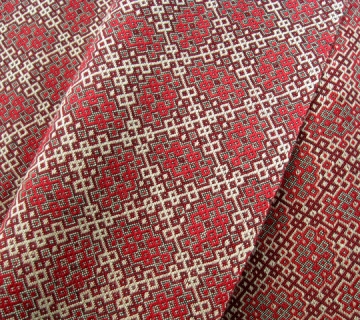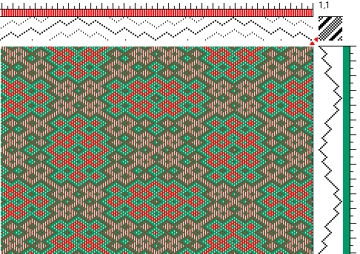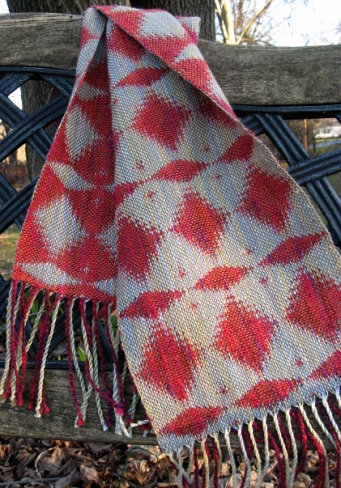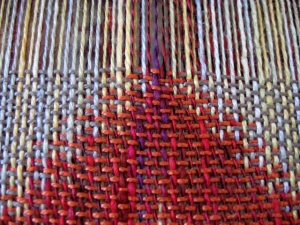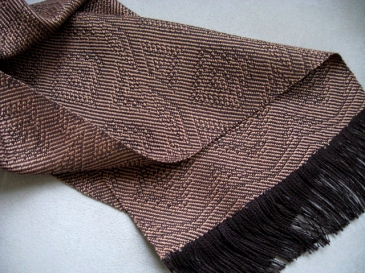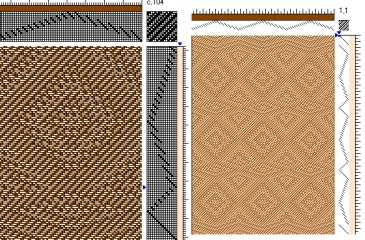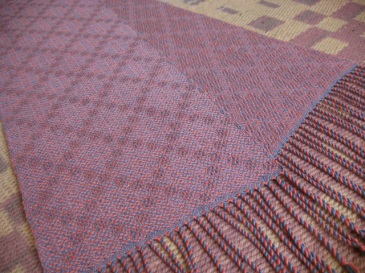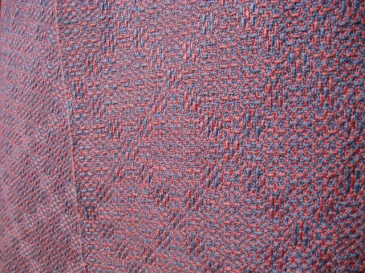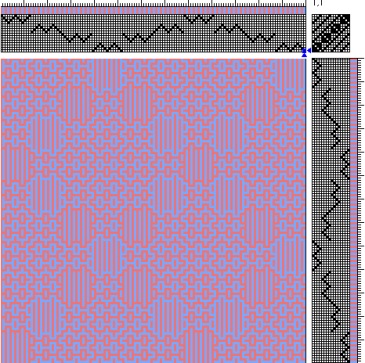It all began with our new dining room table that needed a functional and pretty runner. I say functional first and pretty second because this project was going to be designed so that form follows function and not the other way around. I must confess that sometimes I do weave things out of curiosity without thinking too much about what useful things I can make from them. The pattern I designed for the table runner turned out to be a traditional turned twill block design woven with lustrous pearl cotton. I liked the clean lines between the warp-float and weft-float areas in this design and wondered what a design with fuzzy lines would look like, so I tried that too. Here are photos and drafts of the runner followed by a few more daring adventures:
Turned Twill Woven Table Runner – 4 Blocks
I wove a few samples first, one with a pearl cotton warp and a linen weft that was lovely, but I liked the colors of pearl cotton I had in my stash better. So I wove the table runner using 5/2 pearl cotton for warp and weft with a sett of 24 epi and about 21 ppi, using a very firm beat. A wider sett of maybe 20 or 22 epi would have been better for a more balanced weave woven with a lighter beat. I wove a few inches of plain weave at the two ends with a thin 20/2 cotton so that I could turn and hand stitch a hem for a neat and lasting finish. I should mention that I used a floating selvedge on each side that was not threaded through a heddle, only sleyed through the reed. The woven piece was washed in the washer on gentle and ironed while still damp. The finished runner is 18 inches wide by 60 inches long, perfect for our table:
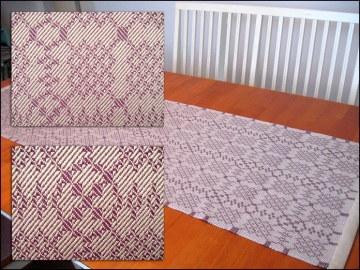
Turned Twill Woven Table Runner, 4 blocks, pearl cotton, 2013
I weave on a 16-shaft treadle loom, good for a 4-block, 3/1-1/3 turned twill pattern. I designed a profile draft where Block A is threaded 1,2,3,4; Block B – 5,6,7,8; Block C – 9,10,11,12; and Block D – 13,14,15,16. The treadling blocks are the same as the threading blocks. The direction of the twill lines depends on whether you treadle top to bottom or bottom to top. I chose to weave it so that the warp-float twills go left to right and the weft-float twills go right to left on the side that I wanted to show when I place it on the table, the way you see it in the above photo. You can repeat the blocks in a profile draft to your liking, easily accomplished with weaving software, and with block substitution you can try it out with different weave structures. Below are the profile draft followed by the thread-by-thread draft and a close-up of the draft that shows how the warp and weft are interlaced:
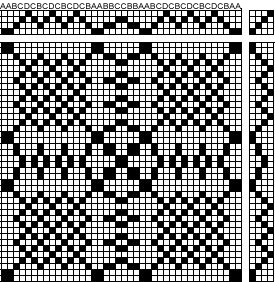
PROFILE DRAFT for Turned Twill Woven Table Runner, 4 blocks

Draft for Turned Twill Woven Table Runner, 4 blocks
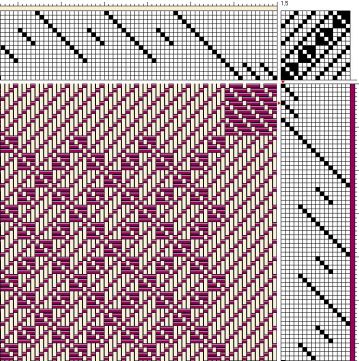
Close-up of Draft for Turned Twill Woven Table Runner, 4 blocks (interlacement view)
Without elaborating too much, I would describe turned twill as an uneven twill, and in this project, blocks are made up of 4-end units of 3/1 twill and 1/3 twill. The contrast between warp-float and weft-float areas on the same side of the fabric can be used to design many kinds of patterns – from stripes to fancy figures. Sometimes turned twill is referred to as twill damask. Irene Emery describes it in great detail in her book, The Primary Structures of Fabrics. To learn more about blocks and profile drafts, I recommend Madelyn van der Hoogt’s book, The Complete Book of Drafting for Handweavers, Chapter 5: From Blocks to Units. I think Madelyn also has a video out about block weaves. I have a few past posts with profile drafts, you can find them if you go to my home page and click on “Profile Drafts” in the Categories cloud.
Networked Twill Woven Fabric – Turned Twill with Fuzzy Borders
After the table runner project, I continued experimenting with turned twill but digressed and kept only the tie-up and instead of blocks I tried networked threadings and treadlings. I liked the fuzzy borders, very different than the clean cut ones in traditional block turned twill, and the longest float was still only 3. I also read an article by Alice Schlein in Handwoven magazine in 2001, “Network Drafting – Turned Twills on Eight Shafts,” that inspired me to experiment with this idea. Below is a photo of some yardage I wove from one of my designs using 20/2 cotton in alternating dark and light colors in the warp and a solid color for the weft, at 42 epi and about 40 ppi. I washed the yardage by hand and ironed it while it was still damp. The yardage is a bit narrow in width, about 16 inches, not really functional for my purposes, but hey, it’s kind of interesting and I may use it for next year’s Fine Threads Study Group at Complex Weavers, cut into swatches for members of my group:
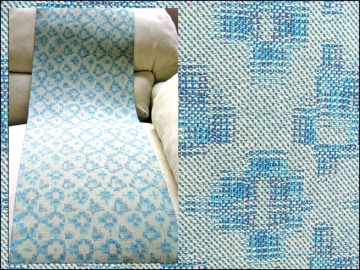
Networked Twill Woven Fabric, cotton, 2013
Below are the drafts for the fabric.
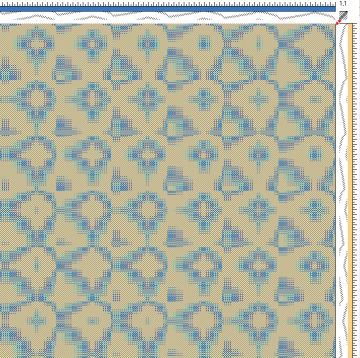
Draft for Networked Twill Woven Fabric
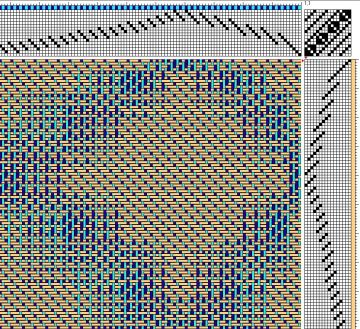
Close-up of Draft for Networked Twill Woven Fabric (interlacement view)
More Turned Twill Drafts – Variations
These are drafts I like but haven’t tried to weave. This one with a 5-end advancing twill threading and treadling illustrates the fuzzy borders between the warp-float and weft-float areas, and the longest float is 3:
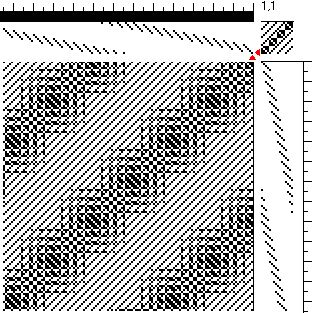
Draft for 5-end Advancing Twill
Here’s an 8-shaft, traditional 2 block draft and the dramatic change that you see when color-and-weave is used on the same draft – 4 dark and 4 light ends alternating in warp and weft:
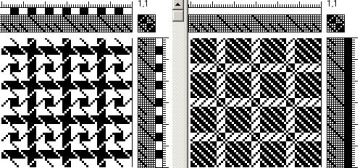
Draft for 8-shaft, 2 block, Turned Twill with color-and-weave version
And here’s the same draft as the previous one, with some fun colors for the color-and-weave effect:

Draft for 8-shaft, 2 block, color-and-weave Turned Twill
Hope you enjoyed reading about my Turned Twill adventures. Just one more thing…
Something Completely Different:
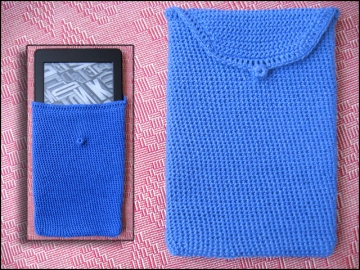
E-Reader Case, Crochet, pearl cotton, 2013
OK, this is not woven, but I just love this little crochet case with the little button that I made for my e-reader. It’s just simple continuous single crochet with 5/2 pearl cotton going round and round and then back and forth for the flap, finished with a double crochet edging. It’s sitting on a shadow weave mat so there is some weaving in the picture!


